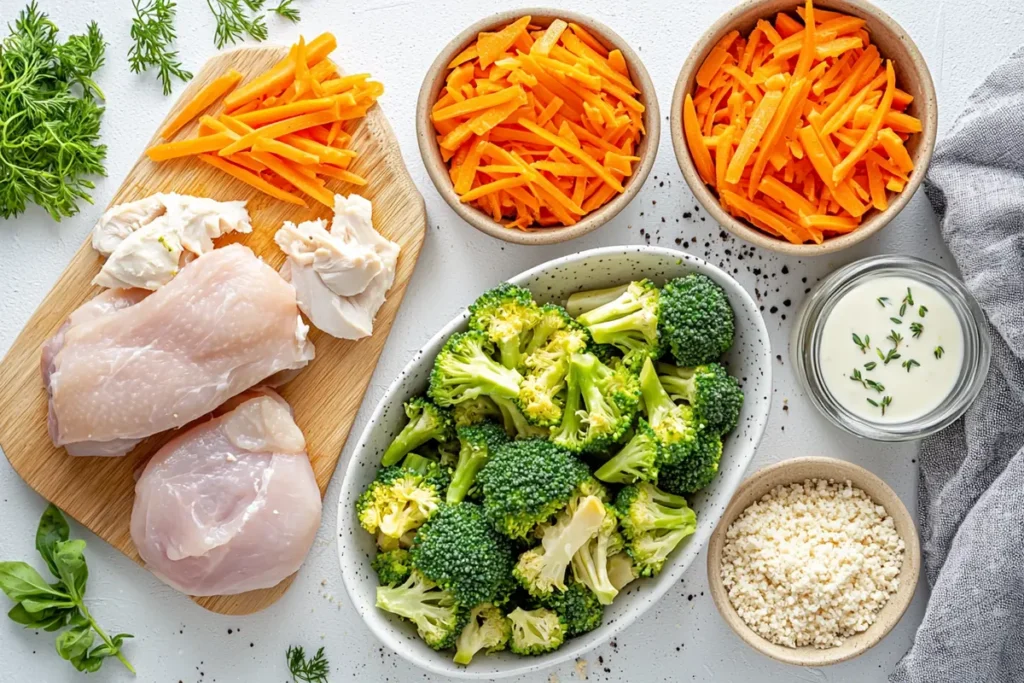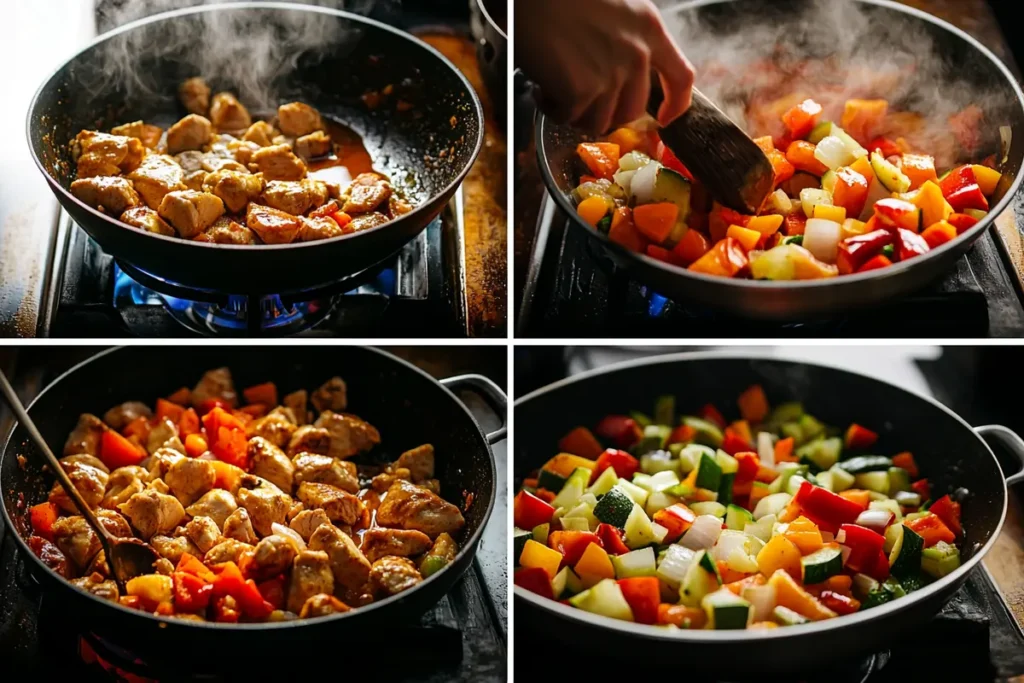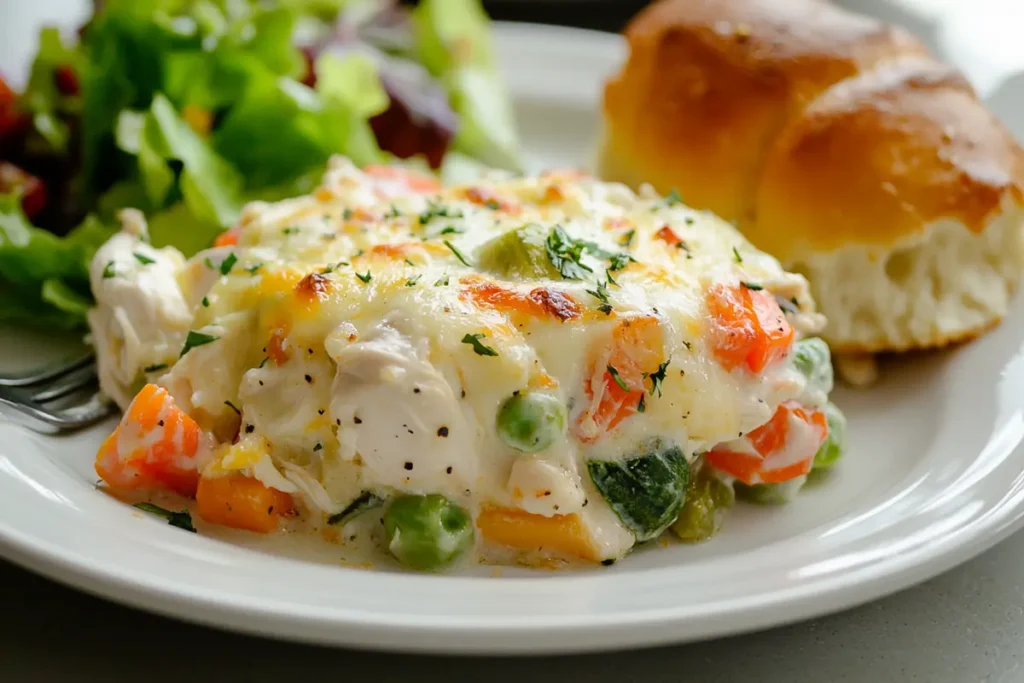When it comes to wholesome, comforting meals, a chicken vegetable casserole stands out as a winner. Not only does it combine tender, protein-rich chicken with a medley of colorful vegetables, but it also offers the rich, creamy texture that makes every bite satisfying. This versatile dish can be tailored to your taste, made ahead of time, and even adjusted for dietary preferences.
What Is a Chicken Vegetable Casserole?
A chicken vegetable casserole is more than just a baked dish; it’s a celebration of flavors and textures, blending tender chicken, vibrant vegetables, and creamy or cheesy goodness into a hearty meal. This one-dish wonder has stood the test of time for good reason. It’s convenient, customizable, and perfect for feeding a crowd without breaking the bank.
Why Chicken Vegetable Casserole Is a Family Favorite
What makes this dish so beloved? It’s simple—its versatility. From picky eaters to gourmet palates, there’s something for everyone. Plus, its balance of protein, vegetables, and creamy textures makes it a wholesome and satisfying option for any meal. With endless variations to explore, it’s easy to see why this dish has become a staple in households worldwide.
Ingredients and Preparation
Essential Ingredients for Chicken Vegetable Casserole

- Chicken: Opt for boneless, skinless chicken breasts or thighs for their tender texture and ease of preparation. Thighs add a slightly richer flavor, while breasts keep the dish lean.
- Vegetables: Choose from broccoli, carrots, peas, or bell peppers. These veggies not only add vibrant color but also pack a punch of vitamins and minerals.
- Sauce: A creamy base is the soul of this casserole. Common choices include cream of chicken soup, sour cream, or even a homemade béchamel sauce for a gourmet touch.
- Toppings: Bring on the texture! Cheese, breadcrumbs, or crushed crackers create a golden, crispy layer that contrasts beautifully with the creamy interior.
Step-by-Step Guide to Preparing a Perfect Chicken Vegetable Casserole

- Preheat the Oven: Begin by setting your oven to 350°F (175°C). This ensures the casserole cooks evenly and develops a perfectly golden crust.
- Cook the Chicken: Season your chicken with salt, pepper, and optional spices like paprika or garlic powder. Sauté it in a skillet over medium heat until fully cooked, then shred or cube the pieces.
- Prepare the Vegetables: Steam or sauté your chosen vegetables until tender yet crisp. This step ensures they don’t turn mushy during baking.
- Make the Sauce: In a mixing bowl, combine cream of chicken soup, sour cream, and a pinch of seasoning. Stir until smooth for a luscious, creamy consistency.
- Assemble the Casserole: In a greased baking dish, start layering. Spread the chicken evenly at the bottom, followed by the vegetables, and then pour the sauce over the top.
- Add Toppings: Sprinkle generously with shredded cheese and breadcrumbs or crushed crackers for a deliciously crispy finish.
- Bake: Pop the dish into the preheated oven and bake for 30–35 minutes. You’ll know it’s ready when the top is bubbling and golden brown.
Pro tip: Allow the casserole to cool slightly before serving for cleaner slices and enhanced flavors.
Variations and Substitutions for Chicken Vegetable Casserole
- Protein Alternatives: Swap the chicken for turkey, ground beef, or even tofu for a vegetarian-friendly version.
- Vegetable Options: Experiment with zucchini, spinach, cauliflower, or even asparagus. Different veggies bring new textures and flavors to the dish.
- Sauce Variations: If you’re out of cream of chicken soup, try cream of mushroom soup for an earthy touch. Alternatively, a tomato-based sauce can add a tangy twist for a unique spin.
Nutritional Information
Health Benefits of Chicken Vegetable Casserole
- Protein Power: With chicken as the primary ingredient, this dish provides an excellent source of lean protein, essential for muscle repair and overall health.
- Vitamin-Rich Vegetables: Whether you include broccoli, carrots, peas, or bell peppers, the vegetables offer a rich supply of vitamins A, C, and K, along with important minerals like potassium and magnesium.
- Fiber Content: Adding vegetables boosts dietary fiber, which aids digestion and supports heart health.
- Healthy Fats: By using low-fat dairy products in the creamy sauce, you can enjoy all the flavor while keeping the fat content in check.
- Optional Carbohydrates: If you decide to pair the casserole with pasta, rice, or a side of crusty bread, you’ll add satisfying carbohydrates for sustained energy.
Calorie Count and Recommended Serving Sizes for Chicken Vegetable Casserole
- Calorie Breakdown:
A typical serving of this casserole contains approximately 400–500 calories. The precise number varies based on the specific ingredients and portion sizes used. For example:- Using full-fat dairy or extra cheese may increase calories.
- Adding more vegetables and lean protein can enhance nutrition without a significant calorie spike.
- Serving Size:
Most recipes yield about 6-8 servings. Portioning your casserole ensures that you’re enjoying the right amount without overindulging. - Pro Tip: Pair your serving with a light side dish, such as a green salad, to keep your meal balanced and refreshing.
Serving Suggestions
Side Dishes to Complement the Casserole

- Salads: A fresh green salad is a classic accompaniment. Toss together mixed greens, cucumber slices, and cherry tomatoes, then drizzle with a light vinaigrette. The crispness of the vegetables provides a refreshing contrast to the creamy casserole.
- Bread: Warm, buttery dinner rolls or slices of crusty artisan bread are perfect for soaking up the rich sauce. If you prefer something with a hint of garlic, homemade garlic bread is an excellent choice.
- Beverages: While alcoholic beverages are not recommended here, an iced tea or a sparkling fruit juice pairs wonderfully with the hearty flavors of the casserole, keeping the meal light and balanced.
Presentation Tips
- Garnish with Fresh Herbs: A sprinkle of fresh parsley or chives not only adds a pop of color but also enhances the aroma and flavor of the dish.
- Serve Rustic or Refined: For a casual meal, serve the casserole directly in the baking dish. Its golden, bubbling top will create an inviting centerpiece. For a more formal setting, plate individual servings with a sprig of parsley or a slice of bread on the side.
Frequently Asked Questions
Can I make this casserole ahead of time?
Absolutely! Preparing the casserole in advance is a great way to save time on busy days. Simply assemble the casserole as instructed, cover it tightly with foil or plastic wrap, and refrigerate for up to 24 hours before baking. When you’re ready to serve, bake it directly from the fridge, adding a few extra minutes to the cooking time.
How do I store leftovers?
Storing leftovers is simple. Transfer the casserole to an airtight container and refrigerate it for up to 3 days. Reheat individual portions in the microwave or warm the entire dish in the oven at 350°F (175°C) until heated through.
Can I freeze the casserole?
Yes, this dish is freezer-friendly! Assemble the casserole but don’t bake it. Cover it securely with foil or a lid, and freeze for up to 3 months. Thaw the casserole in the refrigerator overnight before baking as usual.
What can I use instead of cream of chicken soup?
If you prefer not to use canned soup, a homemade béchamel sauce is a fantastic substitute. Alternatively, you can use cream of mushroom soup for a slightly different flavor profile.
How can I make the casserole gluten-free?
Creating a gluten-free version is easy. Use gluten-free breadcrumbs for the topping and check that all other ingredients, such as soup or sauces, are certified gluten-free. A quick read of the labels will help ensure your dish is safe for gluten-sensitive diners.
Is it possible to make a dairy-free version?
Yes! Swap out the dairy products with plant-based alternatives like almond milk, coconut cream, or vegan cheese. These substitutes work beautifully and cater to those with lactose intolerance or vegan preferences.
Can you bake raw chicken and vegetables in the same pan?
Yes, you can bake raw chicken and vegetables together in the same pan for convenience. However, it’s essential to cut the chicken and vegetables into even pieces to ensure everything cooks uniformly.
Is it OK to bake raw chicken with vegetables?
It’s perfectly safe to bake raw chicken with vegetables, as long as the chicken reaches an internal temperature of 165°F (74°C). Ensure the vegetables don’t overcook by cutting them into appropriate sizes or layering them properly beneath the chicken.
What are the 5 components of a casserole?
Protein: Chicken, turkey, tofu, or beans.
Vegetables: Broccoli, carrots, spinach, or peas.
Binder: Cream of chicken soup, béchamel, or a tomato-based sauce.
Carbohydrates: Rice, pasta, or potatoes for added bulk.
Topping: Cheese, breadcrumbs, or crushed crackers for texture and flavor.

Delicious and Easy Chicken Vegetable Casserole Recipe
- Total Time: PT55M
- Yield: 6 servings
Description
This Chicken Vegetable Casserole is the ultimate comfort food—a creamy, cheesy, and hearty dish packed with tender chicken, vibrant vegetables, and a flavorful sauce baked to bubbly perfection.
Ingredients
-
2 tablespoons olive oil
-
1 lb boneless, skinless chicken breasts or thighs, diced
-
1 teaspoon garlic powder
-
1 teaspoon onion powder
-
Salt and pepper, to taste
-
1 cup broccoli florets, chopped
-
1 cup carrots, sliced thin
-
1 cup frozen peas
-
1 cup red or yellow bell pepper, diced
-
1 can (10.5 oz) cream of chicken soup
-
¾ cup sour cream
-
½ cup milk
-
1 teaspoon Italian seasoning
-
1 ½ cups shredded cheddar cheese, divided
-
1 cup crushed crackers or breadcrumbs
-
2 tablespoons fresh parsley, chopped (optional, for garnish)
Instructions
-
Preheat oven to 350°F (175°C). Grease a 9×13-inch baking dish and set aside.
-
Heat olive oil in a skillet over medium heat. Add diced chicken, garlic powder, onion powder, salt, and pepper. Cook until the chicken is browned and cooked through, about 6–7 minutes. Remove from heat.
-
Steam or lightly sauté the broccoli, carrots, and bell peppers until slightly tender but still crisp.
-
In a large bowl, mix cream of chicken soup, sour cream, milk, and Italian seasoning until smooth. Stir in the cooked chicken, prepared vegetables, frozen peas, and 1 cup of cheddar cheese.
-
Transfer mixture to the prepared baking dish and spread evenly.
-
Sprinkle remaining cheese over the top, followed by crushed crackers or breadcrumbs.
-
Bake uncovered for 30–35 minutes or until hot, bubbly, and golden on top.
-
Garnish with parsley and serve warm.
Notes
Variations: Use turkey instead of chicken, or swap vegetables like zucchini or spinach for variety.
Dairy-Free Tip: Replace sour cream and cheese with plant-based alternatives.
Gluten-Free Option: Use gluten-free cream of chicken soup and certified gluten-free breadcrumbs.
- Prep Time: PT20M
- Cook Time: PT35M
- Category: Dinner, Main Course
- Method: Oven
- Cuisine: American, Comfort Food




